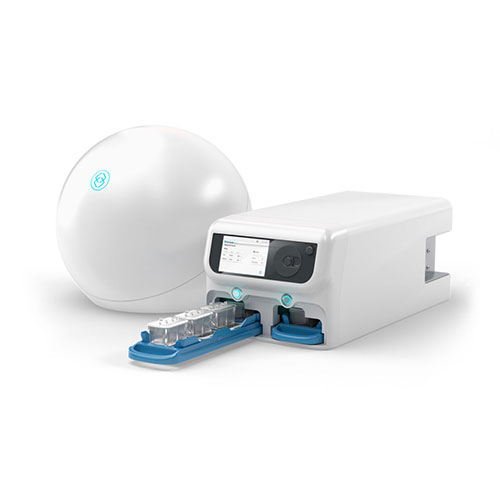

Release time:2022-04-08 15:15

Views:9043
Human Emulation System—— A solution of a complete simulated human organ chip for a new generation of in vitro model
New platform for insight into biology
We have ushered in a new era of drug discovery and development, which is driven by more predictive human biological models.
In the past, drug research and development relied on traditional models, but traditional models can not accurately reproduce human biology or response to treatment. Therefore, only 10% of the project drugs can be approved successfully.
Fortunately, we now have a better way.
By using human simulation system, you can simulate human diseases and their response to candidate drugs in the laboratory. The system uses advanced simulation human organ chip technology. Compared with traditional models such as animals and microspheres, the system can more faithfully simulate the real biological state of human body.
Therefore, you can have a deeper understanding of human diseases and a more accurate understanding of the impact of candidate drugs early in the drug development process.
One system, unlimited application
Compared with the traditional model, the simulated human organ chip technology reproduces the microenvironment in the human body and simulates the human response more truly. Different from other schemes, the human body simulation system provides an open platform for reproducing human physics using organ chip. Therefore, you can model any organ application of interest for any study.
Applications include:
Excretory toxicity: more accurately predict the excretory toxicity characteristics of candidate drugs.
Inflammation: cancer explores the complex mechanisms of inflammation and immune response.
Microbiome: insight into human host microbiome interactions.
Infectious diseases: studying infectious diseases and evaluating the effectiveness of treatment.
Cancer: modeling the complex tumor microenvironment to evaluate the safety and effectiveness of immunotherapy.
Neuroscience: promote the discovery and development of drugs for neurodegenerative diseases.
The organ chip supports:
Lung airway microarray: primary co culture model, characterized by cell differentiation and functional cilia increase, reproduces the key characteristics of airway physiology
Alveolar chip: primary co culture model of alveolar capillary interface, with gas-liquid interface, which can be stretched circularly to simulate respiration
Brain chip: the most comprehensive in vitro model of neurovascular unit, with five cell types in a dynamic and adjustable microenvironment
Colon chip: the only model that combines primary organoids and colon endothelial cells with mechanical force to simulate physiology in vivo
Duodenal chip: primary organoids and duodenal endothelial cells were co cultured under mechanical force to solve the limitation of cell line
Liver microarray: four human cell types are co cultured in a dynamic microenvironment to support similar gene expression, function and physiology in vivo
Proximal tubular microarray: coculture primary human renal cells in flow to improve cell function and response to candidate drugs
Design your own chip: using the open platform method of human simulation system, you can create chips for any organ through our basic research suite and your own cell source
Prediction ability of simulated human organ chip technology
You can more accurately predict the response of systemic organs to candidate drugs by using organ chip. Whether you use the qualified cells found in our organ specific toolkit or your own cell source, each organ chip reproduces the microenvironment required for human response.
Cell crosstalk: two different culture channels are used to regenerate complex biology, and cell-cell interaction is realized through porous membrane.
Flexible cell sources: a variety of human cell sources can be used, including primary cells, induced pluripotent stem cells (IPSC), organoids and cell lines.
Biological complexity: integrate relevant biological components into each chip, including tissue-tissue interface, fluid flow, immune cell interaction, microorganisms and mechanical forces.
Unique toxicological predictability
In the largest organ microarray study to date, 780 liver microarrays were evaluated to assess the toxicity risk of blind groups of 27 known hepatotoxic and non-toxic drugs. The sensitivity and specificity of liver microarray were 87% and 100%, which were better than animal model and microsphere model. The results support the application of liver chip in the workflow of preclinical toxicological evaluation. At the same time, the published data of liver microspheres showed that the sensitivity and specificity of the same drug group were 47% and 100%. A computational economics analysis shows that based on this performance, liver chip can save $3 billion in small molecule drug research and development every year by improving R & D efficiency.
Complete solution for simulating human organ chip
Human body simulation system combines flexible and open instruments, consumables and software systems. Each component is designed to improve the availability and ease of use of chip simulation human organ technology, enabling you to create robust and reproducible data for your drug discovery and development projects.
Organ chip: at the center of our system, each organ chip carries human living cells in an organ specific microenvironment to improve human relevance.
Pod ® Portable module: as organ chip and Zo ë - cm2 ™ The interface of the culture module, the chip is loaded on the pod, the culture medium and effluent are loaded, and can be compatible with laboratory equipment.
Zoë-CM2 ™ Culture module: Zo ë maintains the life of cells in the organ chip by automating the precise conditions required by the culture chip (up to 12).
Orb ® Central module: orb is connected to the standard laboratory output to provide gas for up to 4 Zo ë - cm2.
Software: our software suite helps you design organ chip research, remotely control and monitor your Zo ë - cm2, and analyze your results.